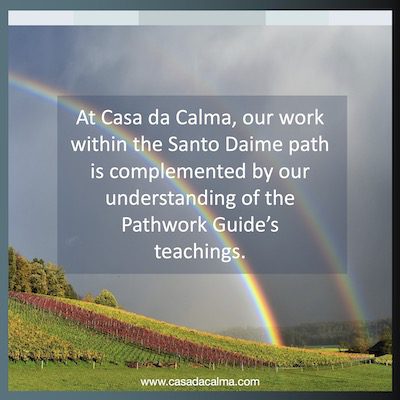
At Casa da Calma, our work within the Santo Daime path is complemented by our understanding of the Pathwork Guide's teachings.
Santo Daime has many sisters
The inspiration to form the Santo Daime religion came through a man called Mestre Irineu—or Mestre, which means “master,” for short—about a hundred years ago. The being who appeared to Mestre was the Queen of the Forest. She is understood to also be Mary, the mother of Jesus.
Santo Daime, then, comes from an eclectic combination of an indigenous South American tradition together with its African heritage along with a strong influence from the Catholic church. This is why there are numerous mentions of the sun, the moon, the stars, and the sea in the hymns, along with God, Jesus, Mary and Joseph.
There are also numerous references to various Orixas, who are the beings associated with the various elements of Earth, and caboclos, who are indigenous beings associated with the forest, along with Saint John the Baptist and Saint Michael the warrior and protector.
To receive the gifts of Santo Daime is to receive a gift from Christ as well as from nature. Because Christ wants to help us heal and shine our own light into the world. And we are fundamentally all part of nature. It is Christ who assures this world has many different paths that can lead us home. This encourages—and often even requires—that we work together in finding the unity that connects them.
The history of two powerful spiritual paths
If we look at the history of Santo Daime in Brazil and Pathwork in the US, we can see a point in time when the Spirit World may have intended for the two to weave together for mutual growth. In the end, Pathwork was spread to Brazil where there are now many Pathwork communities. And Santo Daime communities began to emerge in the US. But for various reasons, the Santo Daime religion was never really successfully merged with the Pathwork teachings, and vice versa.
Yet these two paths are fundamentally very compatible. Both focus on the need to clear away our inner obstacles, with the Pathwork providing extensive teachings about the origin of our inner obstacles and how to transform them. The Santo Daime brings us directly into experiences where this transformation can happen. This kind of personalized help from the Daime is remarkable.
Both Santo Daime and Pathwork are Christic paths, meaning Christ has inspired each of them and guides us in working with them. At Casa da Calma, our work within the Santo Daime path is complemented by our understanding of the Pathwork Guide’s teachings and our intention to attend to all aspects of the healing journey.
Combining humility with brotherhood and sisterhood
Madrinha Baixinha and her husband founded a church in Lumiar, Brazil called Flor da Montanha. It was formed by blending two spiritual paths, Umbanda and Santo Daime. She called it Umbandaime. From the Umbanda traditions, which originated in Africa, come the teachings of the Orixás, which are the many beings responsible for various aspects of Earth. It was by weaving these two paths together that she created something special and powerful.
In hymn #84 in Guia Mestre, Baixinha says:
| This Side and the Other | Esse Lado e o de Lá |
| Who comes through the Doctrine | Quem vem pela Doutrina |
| In Umbanda will arrive | Na Umbanda vai chegando |
| Who arrives in Umbanda | Quem chega na Umbanda |
| In the Doctrine will stay | Na Doutrina vai ficando |
One of the Higher Self qualities we ask the Daime to help us acquire is humility. In fact, the topic of developing humility appears over and over in the hymns. For humility is the divine essence we discover when we overcome our pride. And according to the Pathwork Guide, pride is a highly destructive fault and one of the most difficult to overcome. Humility then is not easy to develop, but it is absolutely necessary if we are to advance on our path.
For some, it may be humbling to simply acknowledge the benefit of bringing together the teachings from more than one spiritual path. But this is how humanity grows, by working together. We can also see Christ’s fingerprints in the way the merging of any two spiritual paths calls forth both humility and unity in the service of healing.
As Baixinha says in Guia Mestre, in hymn #56:
| Who Waits Always Reaches | Quem Espera Sempre Alcança |
| Jesus sent us here | Jesus nos mandou aqui |
| For us to work together | Para juntos nós trabalhar |
Learn more about how we integrate Pathwork into spiritual development.
About Casa da Calma: What to expect • Visitor information • Visitor forms • How to get here • Contact us
About Santo Daime: How Santo Daime heals • Santo Daime hymns • Santo Daime and addictions • Santo Daime and Pathwork
About Mediumship: Part 1: The purpose of mediumship • Part 2: Influence between the Spirit World and humanity • Part 3: General facts about mediumship • Part 4: Basic attitudes, laws and protection • Part 5: Practices, pitfalls and confusions, and limits • Part 6: Mediumship in Santo Daime


